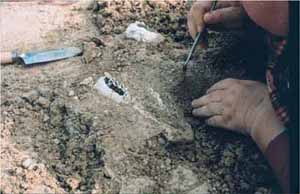Vertebrate Paleontology
 The museum’s collections of over 19,000 lots (more than 43,000 specimens) come from
over 1,100 localities and emphasize Louisiana’s early Tertiary marine, and middle
Tertiary and Pleistocene terrestrial faunas.
The museum’s collections of over 19,000 lots (more than 43,000 specimens) come from
over 1,100 localities and emphasize Louisiana’s early Tertiary marine, and middle
Tertiary and Pleistocene terrestrial faunas.
Of special importance are the large and growing Louisiana Miocene fossil collection from Fort Polk and the Tunica Hills area. Early Tertiary specimens include the front third of the skeleton of the fossil whale Basilosaurus, the best specimen of this ancient whale known to science. Middle Tertiary specimens include specimens of Miocene fossil mammals, including elephant and camel relatives, bats, hedgehogs, and three-toed horses. Pleistocene specimens include the remains of Ice Age animals, such as the elephant-like mastodon.
The museum holds the second-largest collection of fossil specimens from Big Bend National Park, ranging from late Cretaceous dinosaur specimens to small mammals from the beginning of the Age of Mammals.
The collection of casts of early Tertiary mammals from China is among the best in the nation and was obtained as part of an ongoing LSU program of cooperative research on Chinese vertebrate fossils, especially those from near the Paleocene/Eocene boundary when modern mammal groups were evolving.
The vertebrate paleontology section has a volunteer program involving community volunteers in research.
Mason Kirkland, Collections Manager
Dr. Suyin Ting, Consultant

Dr. Schiebout excavating a fossil camel from the Fort Polk Miocene

Dr. Ting at Joe’s Bonebed in Big Bend, West Texas